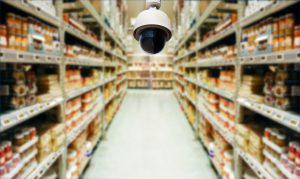
In 2016, retailers in the US lost about $48.9 billion to shrinkage. These losses included everything from shoplifting to employee theft, in-store vandalism and fraud. Fully integrated security systems can significantly increase profits by reducing this shrinkage while also protecting employees. Security system technology—including surveillance cameras, access control and critical communication systems—allows retailers to protect their bottom line better while maintaining a welcoming atmosphere for customers.
Issues That Make Retail Security System Technology Less Effective
All retailers need fully updated security system technology. Outdated components, poorly designed setups or system failures all can be exploited by potential shoplifters. Common issues include:
Surveillance
Ineffective angles and poor quality footage can interfere with loss control’s ability to see high-risk areas. When these areas are visible, the footage is often of such poor quality that little can be done to identify perpetrators.
Access Control
Controlling foot traffic for customers and staff can get unwieldy. Access control allows retailers to control the flow of traffic without requiring additional staff.
Critical Communications
Without critical communication systems in place, staff members may have to leave their registers to find assistance when needed. That creates a hole in security and an opportunity for thieves.
Tools Retailers Can Use To Make Loss Prevention More Effective
Making retail security system technology more effective is not only about updating individual components, but also integrating these various systems to work cohesively as a single unit. The ability for all these systems to work together is what will determine its strength. Loss prevention is supported by the ability of these systems to alert them and help them monitor perpetrators to limit losses from theft.
Surveillance
When adequately angled and installed, security cameras can cut down on both shoplifters and employee theft. Blind spot monitors expand the ability of your system and act as deterrents, reducing the risk of theft in the first place. As shoplifters frequently seek out in-store blind spots, blind spot monitors reduce the opportunity for theft.
Access Control
Door alarms can help manage foot traffic by alerting employees when customers enter high expense areas. Keycards and magnetic locks close off areas like electronics and jewelry on a “need to access” basis. Effective systems will trigger alarms when unauthorized personnel pass access points.
Critical Communications
Critical communications systems should allow employees reach others without the need to leave their stations. They also ensure proper police notification. These systems reduce risk to employees, allowing trained security personnel to confront perpetrators rather than untrained retail workers.
To ensure all these systems work the way they are supposed to, retailer loss prevention leaders need to seek out full system reviews from experienced integrators. Certified integrators will be able to provide blueprints to eliminate in-store blind spots, create effective theft detection systems and support critical communication programs store-wide.
Integration of retail security systems is a critical link in this situation. Cohesive systems help surveillance programs to properly notify loss control personnel, who can then restrict the perpetrator’s movements and consistently monitor them until the police or other security personnel arrive. A fully integrated system can support an entire shrinkage control plan by putting the onus of managing it on objective security technology and not subjective, untrained employees.

